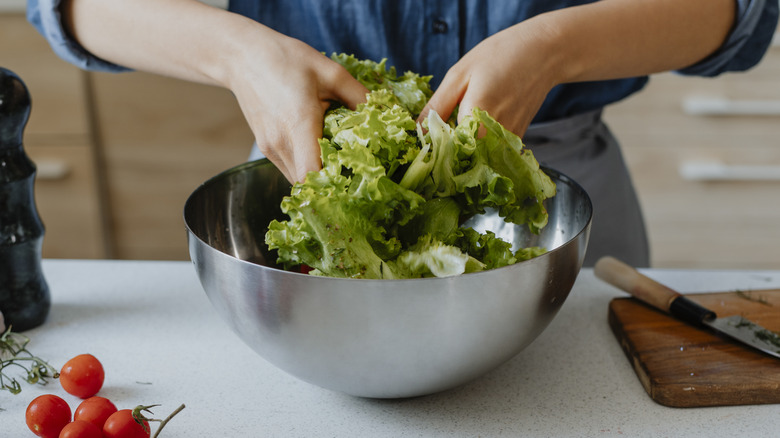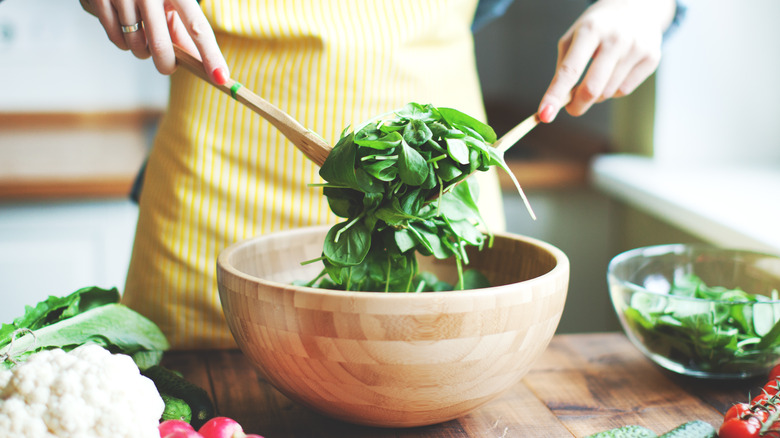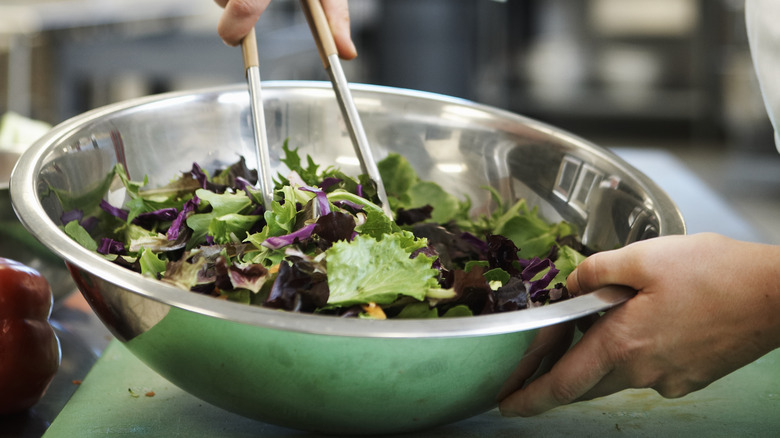A Mixing Bowl Really Is Essential For A Perfect Salad Of Any Size
Making a salad might seem like a straightforward task: Just gather the freshest ingredients you can find, chop them up, and mix them with a tangy dressing. While this is a good starting point, crafting an exceptional salad requires more than just these basics. You need those fresh ingredients, along with a set of essential tools, with the most crucial being a well-sized mixing bowl that can accommodate the specific salad you're preparing.
If you've ever worked in a restaurant, you've likely observed this practice in action and might even have a collection of mixing bowls at home for various culinary tasks beyond salads. In restaurant kitchens, chefs on the line commonly use large mixing bowls, often made of stainless steel, to toss salad ingredients. However, you don't need professional experience to witness this technique. Just visit your favorite chopped salad spot, order your preferred salad, and watch as each component is placed into a spacious metal bowl, expertly tossed before your eyes, and finally served in a smaller bowl for consumption. Does this meticulous process truly make a difference? Without a doubt.
Determining the ideal bowl size for salad tossing
Choosing the right bowl size largely depends on the size of the salad you intend to enjoy. While many pros suggest that a "larger than you'd expect" approach is optimal for tossing any kind of salad, some provide more specific guidelines. Insights from culinary experts on the internet range from recommending a bowl that's 25% larger than your combined ingredients to one that's three times the size of those ingredients. Although these suggestions provide a useful starting point, it's important to acknowledge that salad-making isn't an exact science. As you continue to create salads, you'll develop a sense of what works best for the typical salad you make.
During the exploratory phase of your salad-making journey, it's advisable to lean towards using a larger bowl. A bigger bowl offers a clearer view of how well the salad's components are balanced. Additionally, delicate ingredients like tender mixed greens remain intact when tossed in a larger bowl. Chef Joseph Buenconsejo of Rooted Seeds Catering emphasized the importance of maintaining the crispness and freshness of greens, to Eating Well, stating, "The most important thing for me in a salad is crisp, fresh greens." Piling these delicate greens atop one another with hefty toppings could lead to undesired wilting.
Other advantages of using a large mixing bowl for salad preparation
Creating a salad in a spacious mixing bowl serves several functions beyond preserving the integrity of delicate greens. Another benefit is you'll be able to get a good idea of the ratio of ingredients. If you've ever encountered a salad that's a mess of toppings atop a mound of undressed greens, you'll appreciate how consistency contributes to a harmonious salad experience.
This consistency is equally vital when dressing the salad. By utilizing a larger mixing bowl, you can gradually add your desired dressing and toss as you go. This method ensures that every ingredient receives a uniform coating of dressing and, surprisingly, reduces dressing consumption. Additionally, it prevents the unfortunate outcome of an overly drenched and soggy salad, a far cry from an ideal lunch. Renowned chef Cesare Casella highlights the importance of the right balance to Serious Eats, "You want the dressing to lubricate the salad, but too much dressing will kill the fragrance and crispness of good ingredients." Employing a large bowl also facilitates taste testing and seasoning adjustments, a valuable tip that elevates the overall quality of your salad creation.


